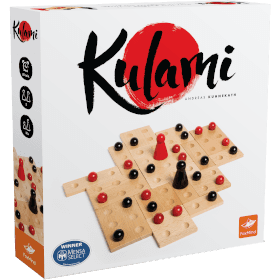kulami
 Kulami, ialah permainan strategi abstrak dua pemain yang dimainkan pada beberapa jubin kayu membentuk papan rawak.
Kulami, ialah permainan strategi abstrak dua pemain yang dimainkan pada beberapa jubin kayu membentuk papan rawak.
Pemain meletakkan kepingan mereka pada petak pada jubin. Peletakan bahagian sebelumnya menentukan baris di mana bahagian seterusnya boleh diletakkan.
Matlamatnya adalah untuk menuntut seberapa banyak jubin yang mungkin dengan menduduki sebahagian besar petak pada jubin.
Bilangan pemain: 2
masa permainan: 10 mn
Kerumitan: 2 / 5
Main kulami dan 1194 permainan lain atas talian.
Tidak perlu dimuat turun - main terus dari laman web anda.
Dengan rakan-rakan dan beribu-ribu pemain dari seluruh dunia.
Percuma.

Main kulami dan 1194 permainan lain atas talian.
Tidak perlu dimuat turun - main terus dari laman web anda.
Dengan rakan-rakan dan beribu-ribu pemain dari seluruh dunia.
Percuma.

Ringakasan peraturan
Kulami is an abstract strategy game for 2 players. Players take turn placing marbles on a board assembled from 17 rectangular tiles, scoring points by having more marbles on those tiles than their opponent at the end of the game.
Setup
The board is randomly assembled from 17 rectangular tiles, each containing a number of holes in which marbles can be placed (4 2x3, 5 2x2, 4 1x3, 4 1x2), either into an 8x8 square or an irregular shape that fits in a 10x10 grid. Each player takes 28 marbles of their color (Red or Black).
Play
Players take turns playing a marble into an empty hole on the board, starting with Red. The first marble may go on any empty space. Each marble thereafter must be played in the same row or the same column as the opponent's previous move, but not on the same tile as either player's previous move. The game ends when all of the marbles have been played, or when a player has no legal spot in which to play a marble.
Scoring
Standard: Each tile is worth 1 point per space to the player with more marbles on it. (For example, if Red has 2 marbles and Black has 1 marble on a 2x2 tile, then Red scores 4 points.) A tile on which the players are tied is worth no points.
The Biggest Areas: In addition to standard scoring, for each player, count their marbles which form the largest horizontally- and vertically-connected area. The player with the larger result scores bonus points equal to the difference. (For example, if Red's largest area has 12 marbles and Black's largest area has 17 marbles, then Black scores 17-12=5 bonus points.)
The Lines: In addition to standard scoring, for each player, identify all lines of 5 or more horizontally, vertically, or diagonally consecutive marbles of their color, and add up their lengths. The player with the larger result scores bonus points equal to the difference. (For example, if Red's has a line of 5 and a line of 7, totaling 5+7=12, and Black has three lines of 5, totaling 5+5+5=15, then Black scores 15-12=3 bonus points.)
Biggest Areas & Lines: Both of the above scoring variants are combined.

